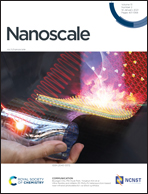Mirror twin boundaries in MoSe2 monolayers as one dimensional nanotemplates for selective water adsorption
Abstract
Water adsorption on transition metal dichalcogenides and other 2D materials is generally governed by weak van der Waals interactions. This results in a hydrophobic character of the basal planes, and defects may play a significant role in water adsorption and water cluster nucleation. However, there is a lack of detailed experimental investigations on water adsorption on defective 2D materials. Here, by combining low-temperature scanning tunneling microscopy (STM) experiments and density functional theory (DFT) calculations, we study in that context the well-defined mirror twin boundary (MTB) networks separating mirror-grains in 2D MoSe2. These MTBs are dangling bond-free extended crystal modifications with metallic electronic states embedded in the 2D semiconducting matrix of MoSe2. Our DFT calculations indicate that molecular water also interacts similarly weak with these MTBs as with the defect-free basal plane of MoSe2. However, in low temperature STM experiments, nanoscopic water structures are observed that selectively decorate the MTB network. This localized adsorption of water is facilitated by functionalization of the MTBs by hydroxyls formed by dissociated water. Hydroxyls may form by dissociating of water at undercoordinated defects or adsorbing of radicals from the gas phase in the UHV chamber. Our DFT analysis indicates that the metallic MTBs adsorb these radicals much stronger than on the basal plane due to charge transfer from the metallic states into the molecular orbitals of the OH groups. Once the MTBs are functionalized with hydroxyls, molecular water can attach to them, forming water channels along the MTBs. This study demonstrates the role metallic defect states play in the adsorption of water even in the absence of unsaturated bonds that have been so far considered to be crucial for adsorption of hydroxyls or water.



 Please wait while we load your content...
Please wait while we load your content...